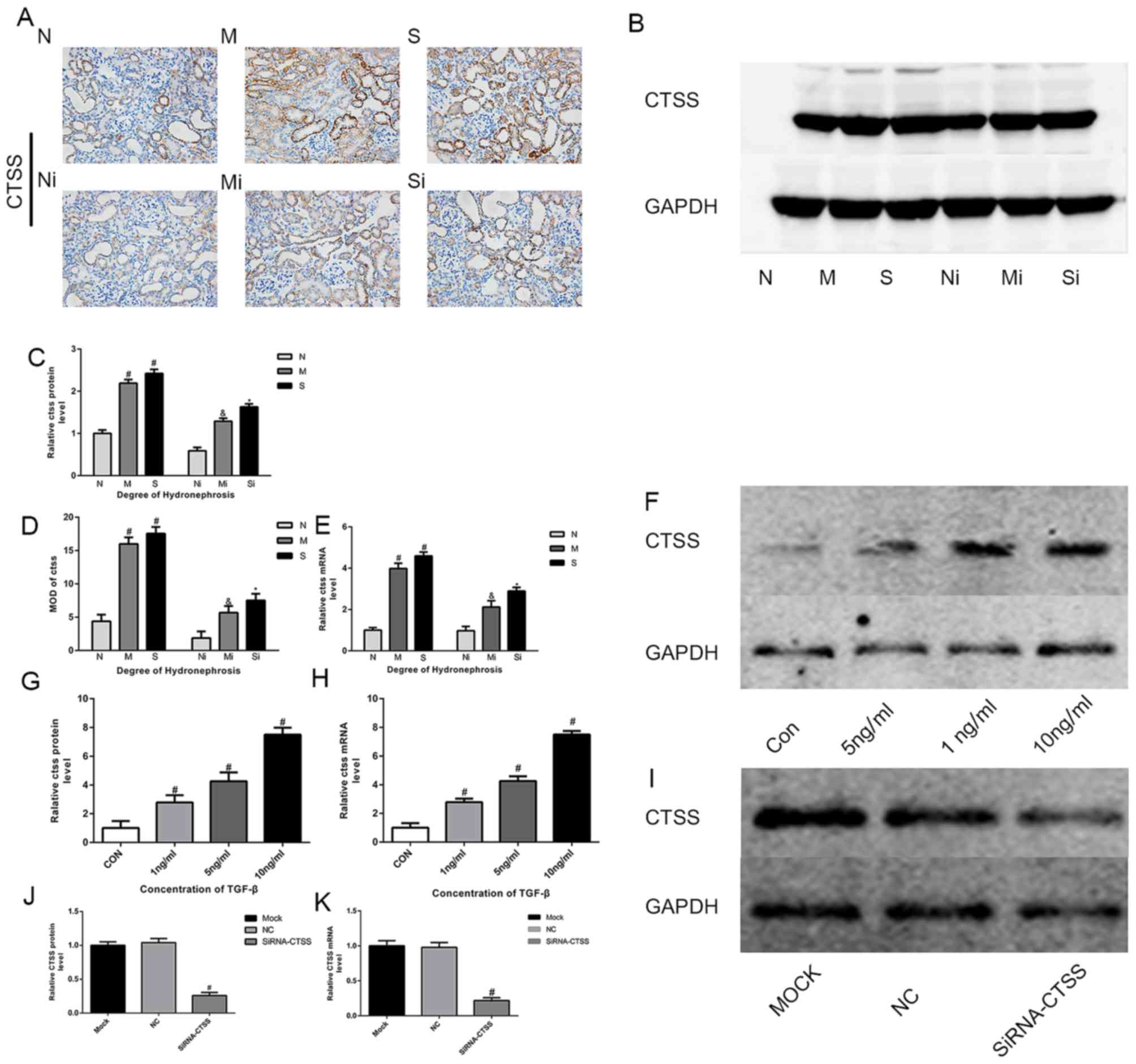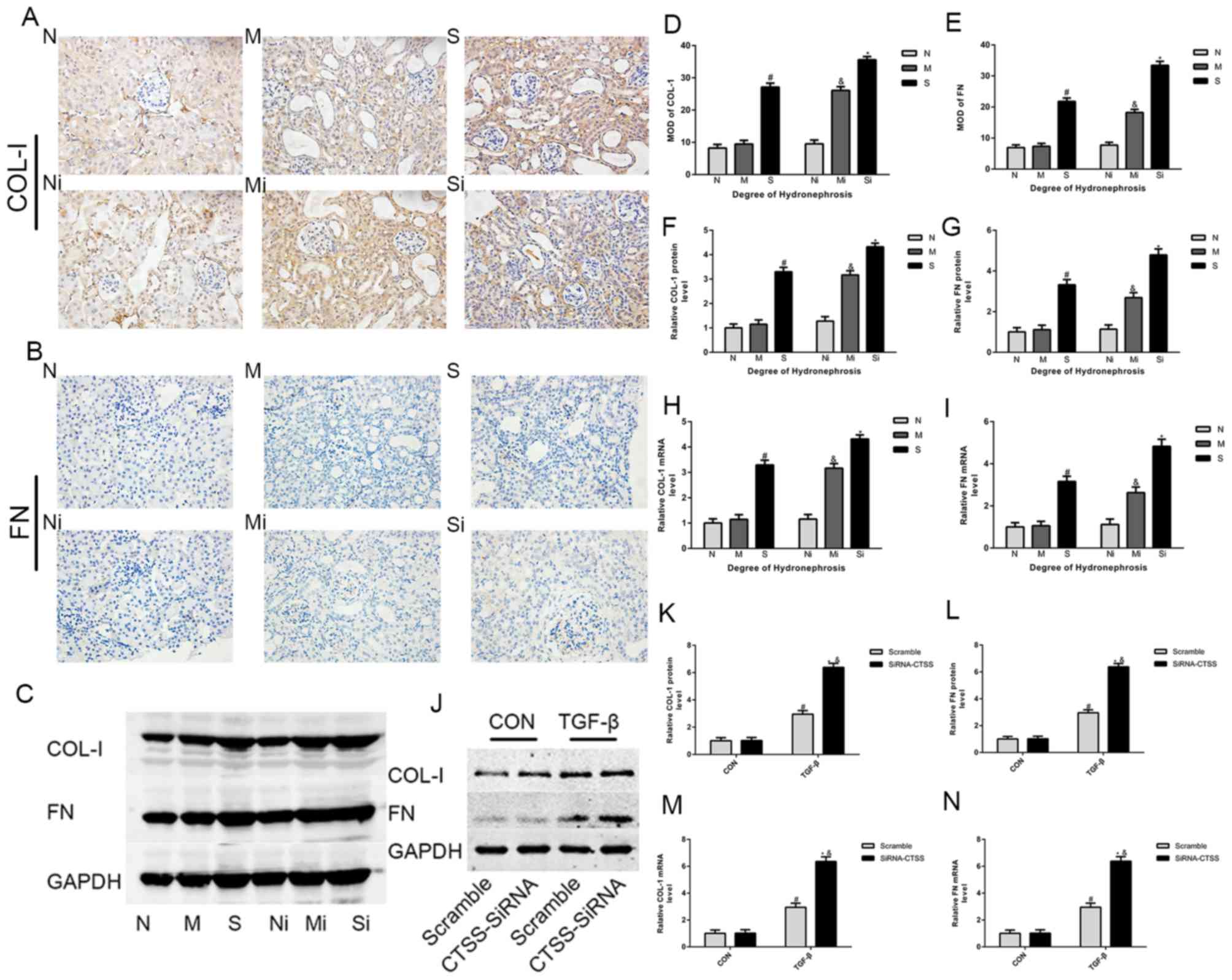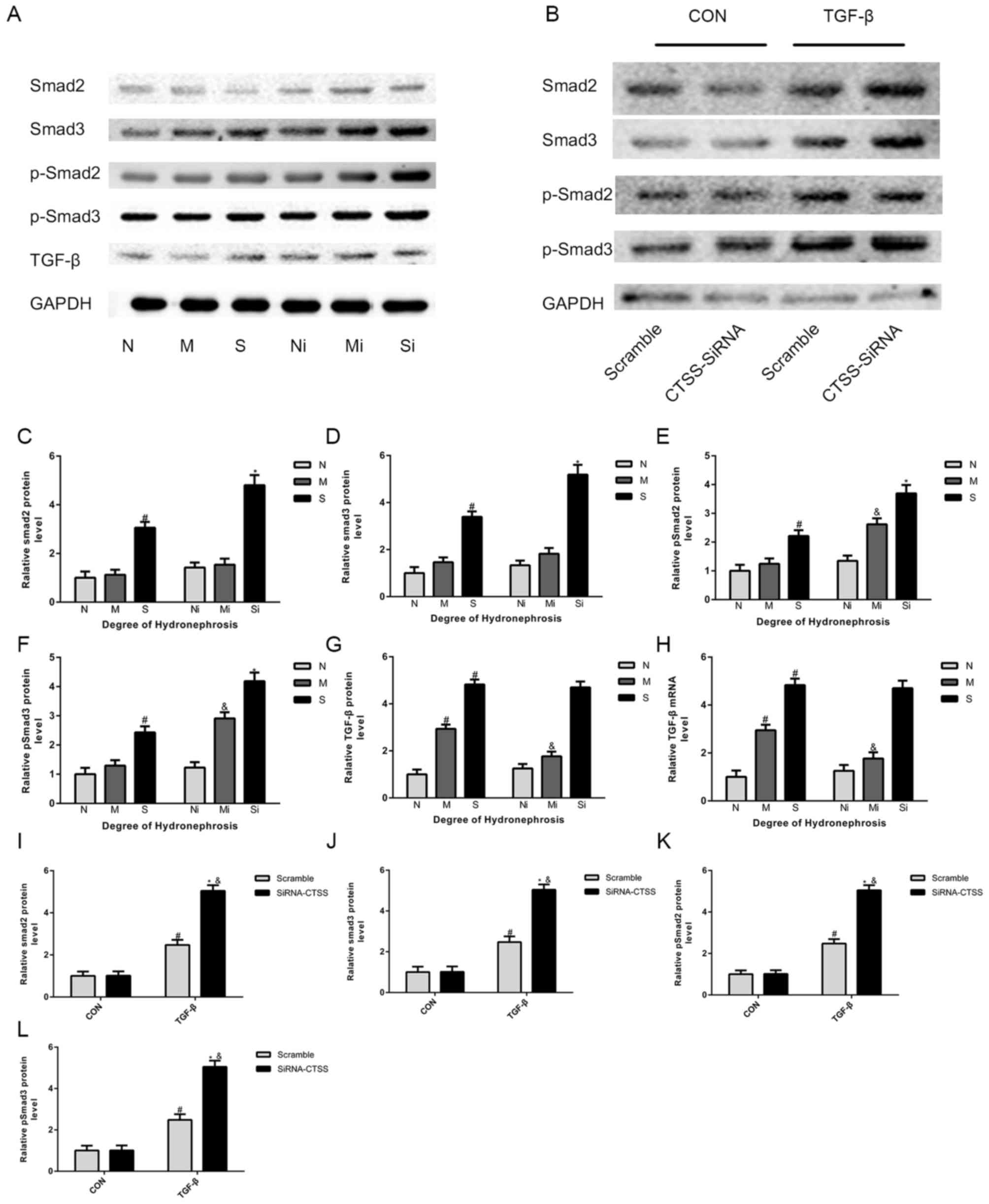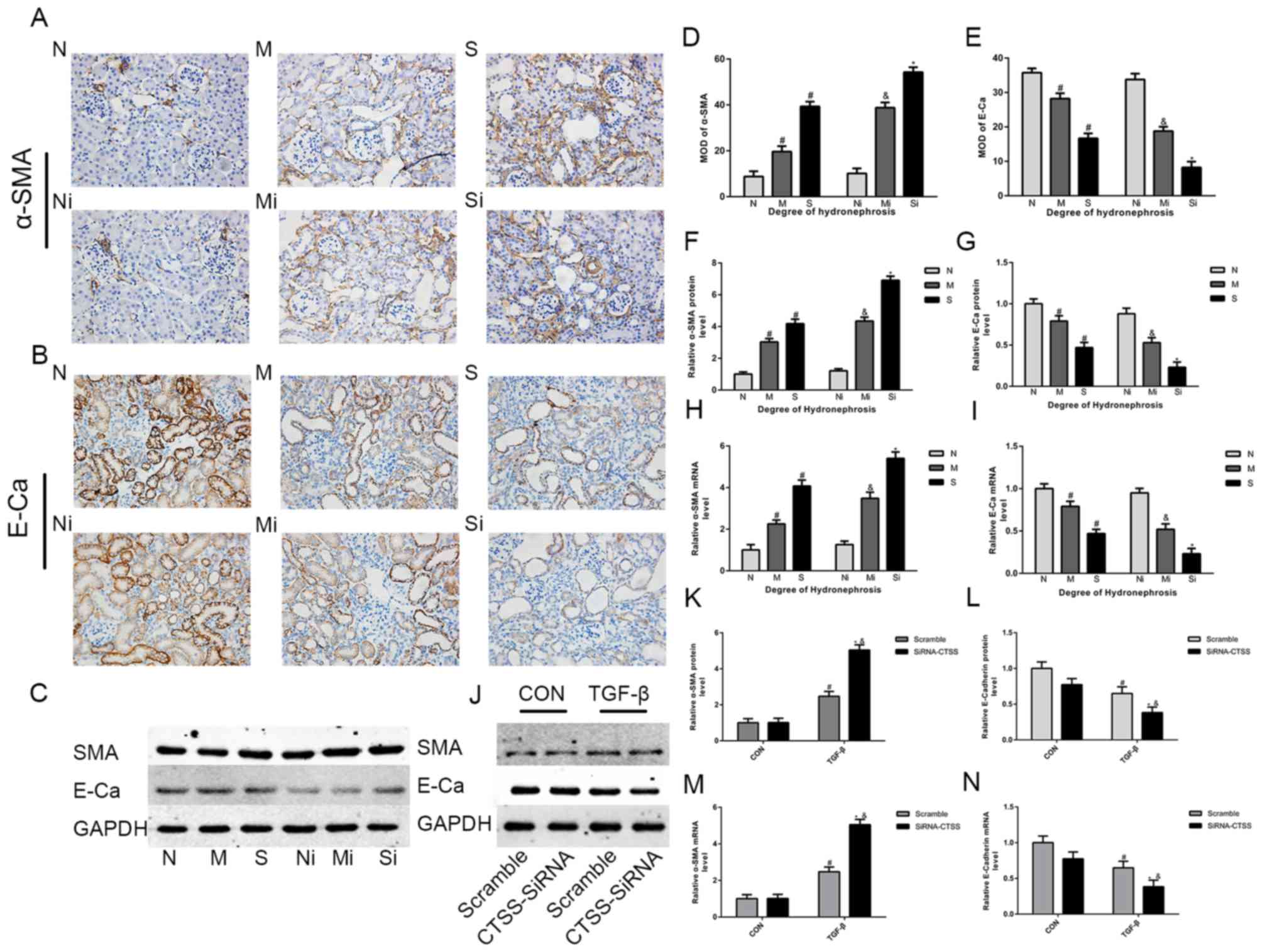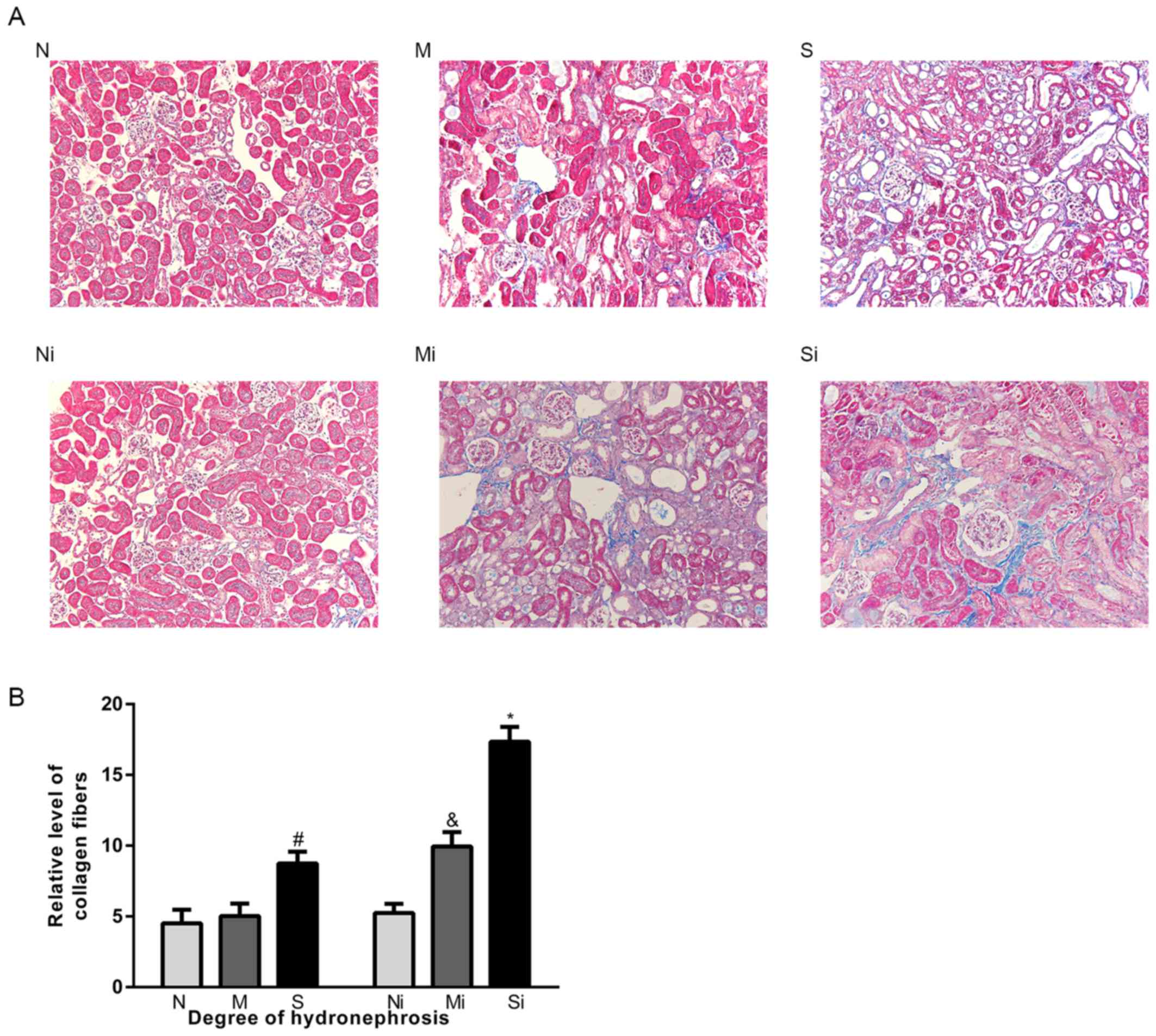|
1
|
Campanholle G, Ligresti G, Gharib SA and
Duffield JS: Cellular mechanisms of tissue fibrosis. 3. Novel
mechanisms of kidney fibrosis. Am J Physiol Cell Physiol.
304:C591–C603. 2013. View Article : Google Scholar : PubMed/NCBI
|
|
2
|
Liu Y: Cellular and molecular mechanisms
of renal fibrosis. Nat Rev Nephrol. 7:684–696. 2011. View Article : Google Scholar : PubMed/NCBI
|
|
3
|
Lovisa S, Zeisberg M and Kalluri R:
Partial Epithelial-to-Mesenchymal transition and other new
mechanisms of kidney fibrosis. Trends Endocrinol Metab. 27:681–695.
2016. View Article : Google Scholar : PubMed/NCBI
|
|
4
|
Nogueira A, Pires MJ and Oliveira PA:
Pathophysiological mechanisms of renal fibrosis: A review of animal
models and therapeutic strategies. In Vivo. 31:1–22. 2017.
View Article : Google Scholar : PubMed/NCBI
|
|
5
|
Pogorzelska A, Żołnowska B and
Bartoszewski R: Cysteine cathepsins as a prospective target for
anticancer therapies-current progress and prospects. Biochimie.
151:85–106. 2018. View Article : Google Scholar : PubMed/NCBI
|
|
6
|
Akkari L, Gocheva V, Quick ML, Kester JC,
Spencer AK, Garfall AL, Bowman RL and Joyce JA: Combined deletion
of cathepsin protease family members reveals compensatory
mechanisms in cancer. Genes Dev. 30:220–232. 2016. View Article : Google Scholar : PubMed/NCBI
|
|
7
|
Brix K, Dunkhorst A, Mayer K and Jordans
S: Cysteine cathepsins: Cellular roadmap to different functions.
Biochimie. 90:194–207. 2008. View Article : Google Scholar : PubMed/NCBI
|
|
8
|
de Mingo Á, de Gregorio E, Moles A,
Tarrats N, Tutusaus A, Colell A, Fernandez-Checa JC, Morales A and
Marí M: Cysteine cathepsins control hepatic NF-κB-dependent
inflammation via sirtuin-1 regulation. Cell Death Dis. 7:e24642016.
View Article : Google Scholar : PubMed/NCBI
|
|
9
|
Chen H, Wang J, Xiang M, Lin Y, He A, Jin
C, Guan J, Sukhova GK, Libby P, Wang JA and Shi GP: Cathepsin
S-mediated fibroblast trans-differentiation contributes to left
ventricular remodelling after myocardial infarction. Cardiovasc
Res. 100:84–94. 2013. View Article : Google Scholar : PubMed/NCBI
|
|
10
|
Cerne D, Stern I, Marc J, Cerne A, Zorman
D, Krzisnik-Zorman S and Kranjec I: CTSS activation coexists with
CD40 activation in human atheroma: Evidence from plasma mRNA
analysis. Clin Biochem. 44:438–440. 2011. View Article : Google Scholar : PubMed/NCBI
|
|
11
|
Weldon S, McNally P, McAuley DF, Oglesby
IK, Wohlford-Lenane CL, Bartlett JA, Scott CJ, McElvaney NG, Greene
CM, McCray PB Jr and Taggart CC: miR-31 dysregulation in cystic
fibrosis airways contributes to increased pulmonary Cathepsin S
production. Am J Respir Crit Care Med. 190:165–174. 2014.
View Article : Google Scholar : PubMed/NCBI
|
|
12
|
Hamm-Alvarez SF, Janga SR, Edman MC,
Madrigal S, Shah M, Frousiakis SE, Renduchintala K, Zhu J, Bricel
S, Silka K, et al: Tear Cathepsin S as a candidate biomarker for
Sjögren's syndrome. Arthritis Rheumatol. 66:1872–1881. 2014.
View Article : Google Scholar : PubMed/NCBI
|
|
13
|
Cao Z, Yu W, Li W, Cheng F, Xia Y, Rao T,
Yao X, Zhang X and Larré S: Acute kidney injuries induced by
various irrigation pressures in rat models of mild and severe
hydronephrosis. Urology. 82:1453.e9–e16. 2013. View Article : Google Scholar
|
|
14
|
Cao Z, Yu W, Li W, Cheng F, Rao T, Yao X,
Zhang X and Larré S: Oxidative damage and mitochondrial injuries
are induced by various irrigation pressures in rabbit models of
mild and severe hydronephrosis. PLoS One. 10:e1271432015.
|
|
15
|
Seseke F, Thelen P and Ringert RH:
Characterization of an animal model of spontaneous congenital
unilateral obstructive uropathy by cDNA microarray analysis. Eur
Urol. 45:374–381. 2004. View Article : Google Scholar : PubMed/NCBI
|
|
16
|
Vielhauer V, Anders HJ, Mack M, Cihak J,
Strutz F, Stangassinger M, Luckow B, Gröne HJ and Schlöndorff D:
Obstructive nephropathy in the mouse: Progressive fibrosis
correlates with tubulointerstitial chemokine expression and
accumulation of CC chemokine receptor 2- and 5-positive leukocytes.
J Am Soc Nephrol. 12:1173–1187. 2001.PubMed/NCBI
|
|
17
|
Livak KJ and Schmittgen TD: Analysis of
relative gene expression data using real-time quantitative PCR and
the 2(-Delta Delta C(T)) method. Methods. 25:402–408. 2001.
View Article : Google Scholar : PubMed/NCBI
|
|
18
|
Inci MF, Ozkan F, Bozkurt S, Sucakli MH,
Altunoluk B and Okumus M: Correlation of volume, position of stone,
and hydronephrosis with microhematuria in patients with solitary
urolithiasis. Med Sci Monitor. 19:295–299. 2013. View Article : Google Scholar
|
|
19
|
Kaissling B, Lehir M and Kriz W: Renal
epithelial injury and fibrosis. Biochim Biophys Acta. 1832:931–939.
2013. View Article : Google Scholar : PubMed/NCBI
|
|
20
|
Hongtao C, Youling F, Fang H, Huihua P,
Jiying Z and Jun Z: Curcumin alleviates ischemia
reperfusion-induced late kidney fibrosis through the APPL1/Akt
signaling pathway. J Cell Physiol. 233:8588–8596. 2018. View Article : Google Scholar : PubMed/NCBI
|
|
21
|
Jha V, Garcia-Garcia G, Iseki K, Li Z,
Naicker S, Plattner B, Saran R, Wang AY and Yang C: Chronic kidney
disease: Global dimension and perspectives. Lancet. 382:260–272.
2013. View Article : Google Scholar : PubMed/NCBI
|
|
22
|
Singh SP, Tao S, Fields TA, Webb S, Harris
RC and Rao R: Glycogen synthase kinase-3 inhibition attenuates
fibroblast activation and development of fibrosis following renal
ischemia-reperfusion in mice. Dis Model Mech. 8:931–940. 2015.
View Article : Google Scholar : PubMed/NCBI
|
|
23
|
Meng X, Nikolic-Paterson DJ and Lan HY:
Inflammatory processes in renal fibrosis. Nat Rev Nephrol.
10:493–503. 2014. View Article : Google Scholar : PubMed/NCBI
|
|
24
|
Cho HS, Kim JH, Jang HN, Lee TW, Jung MH,
Kim TH, Chang S and Park DJ: Alpha-lipoic acid ameliorates the
epithelial mesenchymal transition induced by unilateral ureteral
obstruction in mice. Sci Rep. 7:460652017. View Article : Google Scholar : PubMed/NCBI
|
|
25
|
Bai Y, Lu H, Wu C, Liang Y, Wang S, Lin C,
Chen B and Xia P: Resveratrol inhibits epithelial-mesenchymal
transition and renal fibrosis by antagonizing the hedgehog
signaling pathway. Biochem Pharmacol. 92:484–493. 2014. View Article : Google Scholar : PubMed/NCBI
|
|
26
|
Li L, Zepeda-Orozco D, Black R and Lin F:
Autophagy is a component of epithelial cell fate in obstructive
uropathy. Am J Pathol. 176:1767–1778. 2010. View Article : Google Scholar : PubMed/NCBI
|
|
27
|
Humphreys BD, Lin SL, Kobayashi A, Hudson
TE, Nowlin BT, Bonventre JV, Valerius MT, McMahon AP and Duffield
JS: Fate tracing reveals the pericyte and not epithelial origin of
myofibroblasts in kidney fibrosis. Am J Pathol. 176:85–97. 2010.
View Article : Google Scholar : PubMed/NCBI
|
|
28
|
Iwano M, Plieth D, Danoff TM, Xue C, Okada
H and Neilson EG: Evidence that fibroblasts derive from epithelium
during tissue fibrosis. J Clin Invest. 110:341–350. 2002.
View Article : Google Scholar : PubMed/NCBI
|
|
29
|
Kriz W, Kaissling B and Le Hir M:
Epithelial-mesenchymal transition (EMT) in kidney fibrosis: Fact or
fantasy? J Clin Invest. 121:468–474. 2011. View Article : Google Scholar : PubMed/NCBI
|
|
30
|
Fragiadaki M and Mason RM:
Epithelial-mesenchymal transition in renal fibrosis-evidence for
and against. Int J Exp Pathol. 92:143–150. 2011. View Article : Google Scholar : PubMed/NCBI
|
|
31
|
Kryczka J and Boncela J: Proteases
revisited: Roles and therapeutic implications in fibrosis.
Mediators Inflamm. 2017:25701542017. View Article : Google Scholar : PubMed/NCBI
|
|
32
|
Jadhav PK, Schiffler MA, Gavardinas K, Kim
EJ, Matthews DP, Staszak MA, Coffey DS, Shaw BW, Cassidy KC, Brier
RA, et al: Discovery of Cathepsin S inhibitor LY3000328 for the
treatment of abdominal aortic aneurysm. ACS Med Chem Lett.
5:1138–1142. 2014. View Article : Google Scholar : PubMed/NCBI
|
|
33
|
Cutolo M, Ruaro B, Montagna P, Brizzolara
R, Stratta E, Trombetta AC, Scabini S, Tavilla PP, Parodi A,
Corallo C, et al: Effects of selexipag and its active metabolite in
contrasting the profibrotic myofibroblast activity in cultured
scleroderma skin fibroblasts. Arthritis Res Ther. 20:772018.
View Article : Google Scholar : PubMed/NCBI
|
|
34
|
LeBleu VS, Taduri G, O'Connell J, Teng Y,
Cooke VG, Woda C, Sugimoto H and Kalluri R: Origin and function of
myofibroblasts in kidney fibrosis. Nat Med. 19:1047–1053. 2013.
View Article : Google Scholar : PubMed/NCBI
|
|
35
|
O'Connor JW, Mistry K, Detweiler D, Wang C
and Gomez EW: Cell-cell contact and matrix adhesion promote αSMA
expression during TGFβ1-induced epithelial-myofibroblast transition
via Notch and MRTF-A. Sci Rep. 6:262262016. View Article : Google Scholar : PubMed/NCBI
|
|
36
|
Louis K and Hertig A: How tubular
epithelial cells dictate the rate of renal fibrogenesis? World J
Nephrol. 4:367–373. 2015. View Article : Google Scholar : PubMed/NCBI
|
|
37
|
Grande MT, Sánchez-Laorden B, López-Blau
C, De Frutos CA, Boutet A, Arévalo M, Rowe RG, Weiss SJ,
López-Novoa JM and Nieto MA: Snail1-induced partial
epithelial-to-mesenchymal transition drives renal fibrosis in mice
and can be targeted to reverse established disease. Nat Med.
21:989–997. 2015. View
Article : Google Scholar : PubMed/NCBI
|
|
38
|
Muñoz-Félix JM, González-Núñez M,
Martínez-Salgado C and López-Novoa JM: TGF-β/BMP proteins as
therapeutic targets in renal fibrosis. Where have we arrived after
25 years of trials and tribulations? Pharmacol Ther. 156:44–58.
2015.PubMed/NCBI
|
|
39
|
Zhang D, Sun L, Xian W, Liu F, Ling G,
Xiao L, Liu Y, Peng Y, Haruna Y and Kanwar YS: Low-dose paclitaxel
ameliorates renal fibrosis in rat UUO model by inhibition of
TGF-beta/Smad activity. Lab Invest. 90:436–447. 2010. View Article : Google Scholar : PubMed/NCBI
|
|
40
|
Cheng X, Gao W, Dang Y, Liu X, Li Y, Peng
X and Ye X: Both ERK/MAPK and TGF-Beta/Smad signaling pathways play
a role in the kidney fibrosis of diabetic mice accelerated by blood
glucose fluctuation. J Diabetes Res. 2013:4637402013. View Article : Google Scholar : PubMed/NCBI
|
|
41
|
Moles A, Tarrats N, Fernández-Checa JC and
Marí M: Cathepsin B overexpression due to acid sphingomyelinase
ablation promotes liver fibrosis in niemann-pick disease. J Biol
Chem. 287:1178–1188. 2012. View Article : Google Scholar : PubMed/NCBI
|
|
42
|
Moles A, Tarrats N, Fernández-Checa JC and
Marí M: Cathepsins B and D drive hepatic stellate cell
proliferation and promote their fibrogenic potential. Hepatology.
49:1297–1307. 2009. View Article : Google Scholar : PubMed/NCBI
|
|
43
|
Somanna A, Mundodi V and Gedamu L:
Functional Analysis of cathepsin B-like cysteine proteases from
leishmania donovani complex. Evidence for the activation of latent
transforming growth factor beta. J Biol Chem. 277:25305–25312.
2002. View Article : Google Scholar : PubMed/NCBI
|



